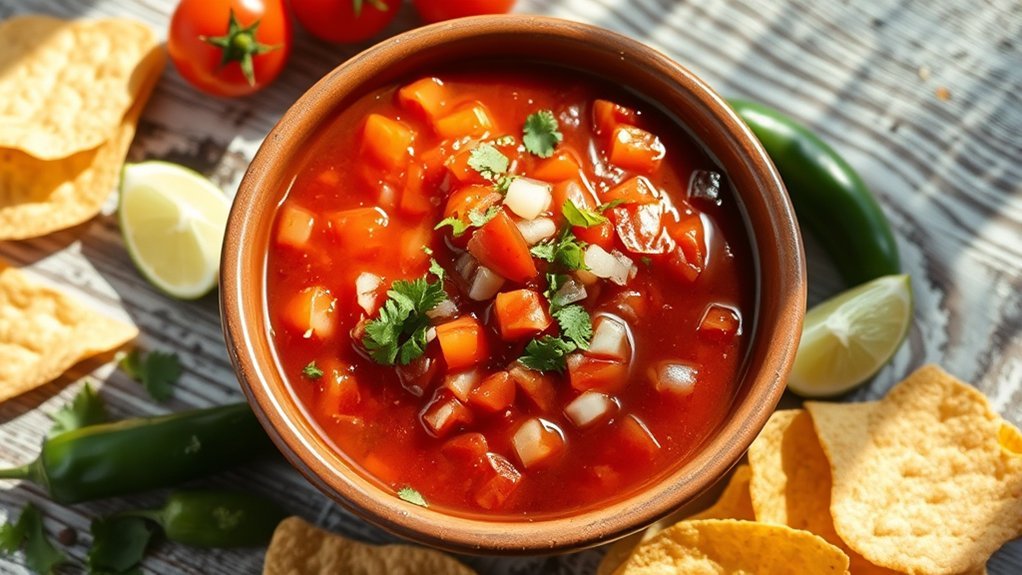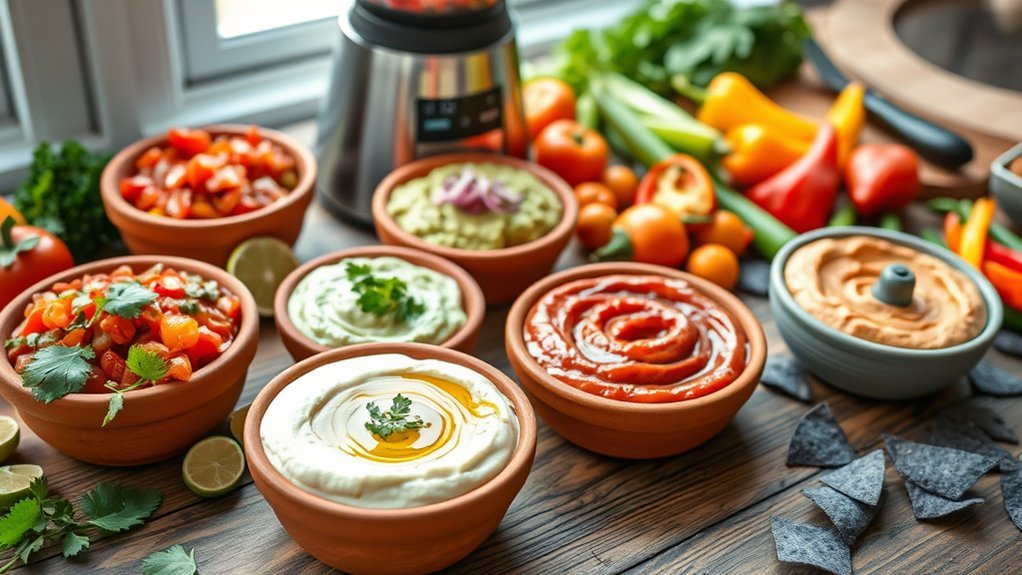Let me tell you, after 20 years of messing around with blenders in my kitchen, I've learned that nothing beats the satisfaction of whipping up your own fresh salsas and dips. Store-bought versions always have that telltale processed taste – you know the one I mean. But grab yourself a decent blender, some ripe tomatoes, and a handful of fresh herbs, and you're in business. I've spent countless hours experimenting with different combinations and textures, from chunky garden-fresh salsas to silky-smooth hummus that'll make your store-bought varieties gather dust in the fridge. Whether you're new to blending or a seasoned kitchen tinkerer, I'm going to walk you through the techniques I've picked up over the years. Trust me, once you start making these from scratch, there's no going back – your taste buds won't let you.
Essential Equipment and Ingredients for Perfect Blender Dips
When it comes to creating delicious homemade salsas and dips, having the right equipment and ingredients makes all the difference. We'll need a reliable blender with multiple blending speed settings, allowing us to achieve the perfect consistency for each recipe. Remember to follow basic blender safety considerations, like securing the lid properly and never placing metal utensils inside while it's running. High-performance blenders with motors exceeding 1,000 watts can handle tough ingredients and provide enhanced versatility in the kitchen.
For our ingredient essentials, we'll want fresh produce like tomatoes, onions, and peppers, along with aromatic herbs such as cilantro and garlic. Don't forget pantry staples including salt, lime juice, and olive oil. Quality ingredients truly transform our dips from ordinary to extraordinary. Also indispensable is a set of measuring tools, sharp knives for prep work, and storage containers to keep our creations fresh.
Mastering Basic Blending Techniques for Salsas
Three essential blending techniques form the foundation of perfect salsa making. We'll start with blending speed techniques, which determine our salsa's final texture. For chunky salsa, we'll use quick pulses, while smooth varieties require sustained blending at higher speeds.
Next, we'll master blending time adjustments – the key to avoiding over-processed ingredients. We want to maintain the fresh, vibrant flavors of our ingredients while achieving the desired consistency.
The final technique involves layering ingredients strategically. We'll add tomatoes and onions first, blend briefly, then incorporate delicate herbs and spices. This progressive approach guarantees each component retains its distinct character while melding into a cohesive whole. By mastering these fundamentals, we're empowered to create salsas that truly reflect our preferences. High-performance blenders can elevate this process by providing powerful, consistent blending that breaks down ingredients more effectively.
Classic Mexican-Style Salsa Variations

Mexican cuisine offers several iconic salsa variations that have become beloved staples worldwide. Let's explore some vibrant recipes that'll add authentic flavor to our dishes. We'll discover how traditional roasted tomato salsa gains its deep, smoky essence through simple charring techniques, and we'll venture into modern fusion creations like pineapple mango salsa that bring tropical sweetness to the table.
Traditional roasted tomato salsa (salsa roja) combines fire-roasted tomatoes, chilies, and garlic for rich depth. Fresh tomatillo salsa verde offers bright, tangy notes with a hint of citrus. Sweet-and-spicy pineapple mango salsa pairs perfectly with grilled fish and tacos.
These versatile salsas let's experiment with heat levels and ingredient combinations while maintaining authentic Mexican flavor profiles. Each variation brings its own character to our culinary adventures.
Crafting Creamy Mediterranean Dips
Moving eastward from Mexico's vibrant salsas, the Mediterranean region offers us a treasure trove of creamy, luxurious dips that have delighted palates for centuries. We'll explore how to create authentic spreads that bring the warmth of Mediterranean hospitality to your table.
Let's master the art of achieving that perfect smooth hummus texture through proper chickpea preparation and tahini balance. By carefully blending soaked chickpeas with high-quality olive oil and fresh lemon juice, we can create a silky base for endless variations.
Our creamy tahini dip begins with lightly toasted sesame seeds, transformed into a luxurious paste that serves as the foundation for classic mezze spreads. These adaptable dips welcome personal touches – try adding roasted red peppers, fresh herbs, or traditional spice blends to make them uniquely yours.
Quick and Easy Party Dip Recipes

While elaborate Mediterranean dips showcase rich cultural traditions, sometimes we need crowd-pleasing party appetizers that can be whipped up in minutes. Let's explore some flavor packed snack ideas that'll revolutionize your next gathering while keeping healthy dip alternatives in mind. We'll show you how to transform simple ingredients into extraordinary dips that'll have your guests asking for the recipe.
- 5-minute black bean and corn salsa that's packed with protein and fresh vegetables
- Creamy avocado-yogurt blend that cuts calories while maximizing taste
- Roasted red pepper hummus that's both vegan-friendly and bursting with antioxidants
These quick recipes prove that delicious doesn't mean complicated. By choosing wholesome ingredients and letting our blender do the work, we're creating dips that are both nutritious and intensely flavorful.
Tips for Storage and Make-Ahead Success
Preparing dips and salsas ahead of time can dramatically simplify party planning, but proper storage is essential for maintaining their fresh flavors and textures. Let's explore the best refrigeration guidelines and proper storage duration for your favorite homemade creations.
| Type of Dip | Storage Container | Maximum Duration | Temperature |
|---|---|---|---|
| Cream-based | Airtight Glass | 3-5 days | 40°F (4°C) |
| Fresh Salsa | Mason Jar | 5-7 days | 40°F (4°C) |
| Bean Dips | Sealed Plastic | 4-6 days | 40°F (4°C) |
| Guacamole | Avocado-Saver | 2-3 days | 40°F (4°C) |
We recommend transferring your dips to appropriate containers immediately after preparation. For ideal freshness, place plastic wrap directly on the surface before sealing to prevent oxidation and maintain consistency.
Troubleshooting Common Blending Mistakes
Many home cooks encounter frustrating blending mishaps when making salsas and dips, but these common problems don't have to derail your culinary efforts. We can tackle blending consistency issues head-on by understanding proper ingredient ratios and essential processing times.
When adjusting seasonings, it's indispensable to blend in small increments and taste frequently to maintain control over the final flavor profile.
If your mixture is too watery, try adding more solid ingredients gradually while pulsing, rather than running the blender continuously. When dealing with tough ingredients like dried chilies, soak them first to prevent uneven blending. For chunky textures, pulse in short bursts and reserve some ingredients to fold in by hand after blending.
Frequently Asked Questions
Can I Use Frozen Ingredients Instead of Fresh Ones for Blender Salsas?
Let's embrace frozen produce selection for our blender salsas! We can swap fresh ingredients with frozen ingredient substitutions, though texture may slightly differ. Just thaw completely before blending for best results.
How Do I Adjust the Spiciness Level Without Ruining the Recipe's Flavor?
We'll help you master adjusting spice intensity! Start with less hot peppers, then gradually add more. For taming heat levels, try adding lime juice or extra tomatoes.
Is It Safe to Can Homemade Blender Salsas for Long-Term Storage?
While 80% of home canning accidents involve salsa, we can safely preserve our blender salsas by following USDA food safety guidelines, using tested recipes, and ensuring proper acidity levels during processing.
Which Blender Settings Work Best for Chunky Versus Smooth Dips?
We'll want low blade speed settings with quick pulses for chunky textures, while smooth dips need higher speeds and longer blending duration. Let's experiment freely to find our perfect consistency!
Can I Substitute Greek Yogurt for Sour Cream in Creamy Dip Recipes?
Ever wondered about dairy substitutions? We're thrilled to confirm that Greek yogurt's thick texture wonderfully replaces sour cream in creamy dips, offering a tangy, protein-rich twist that's actually healthier.

